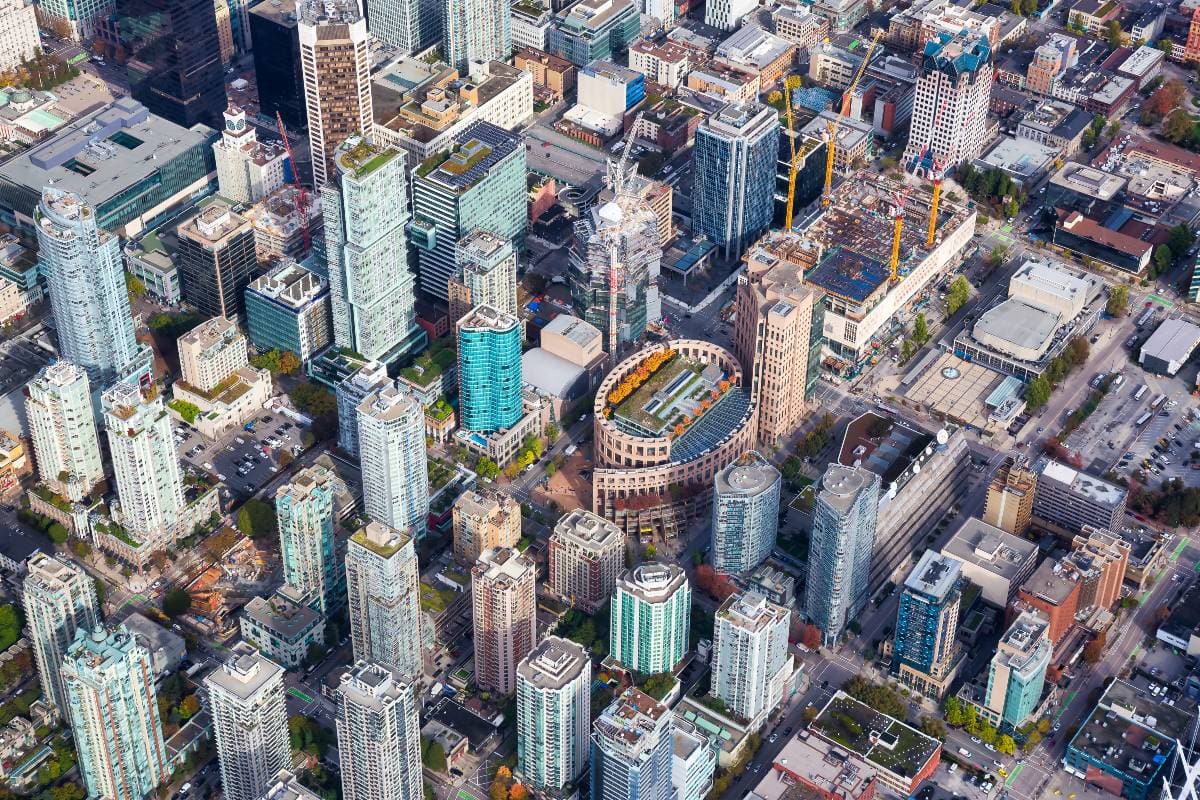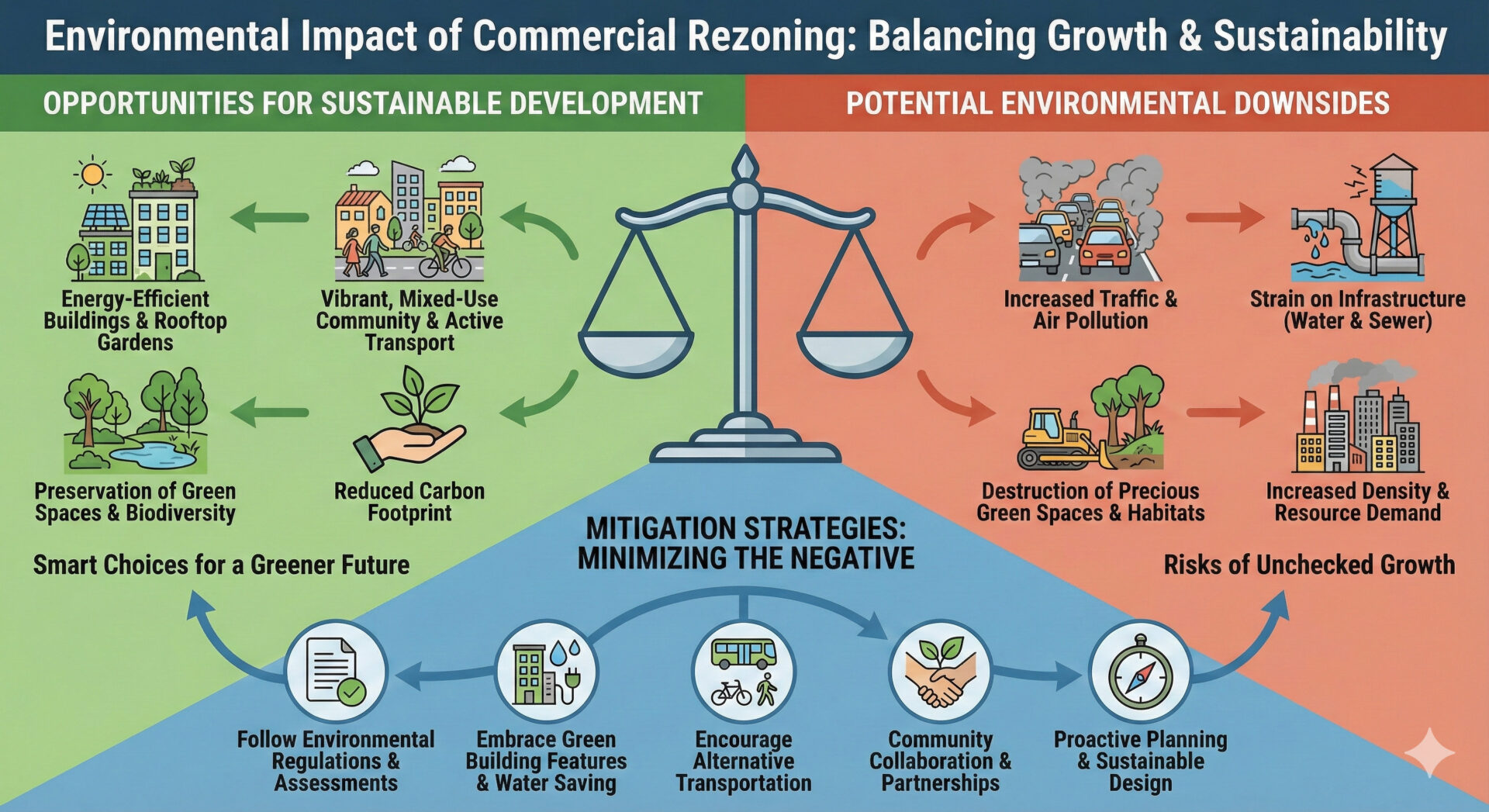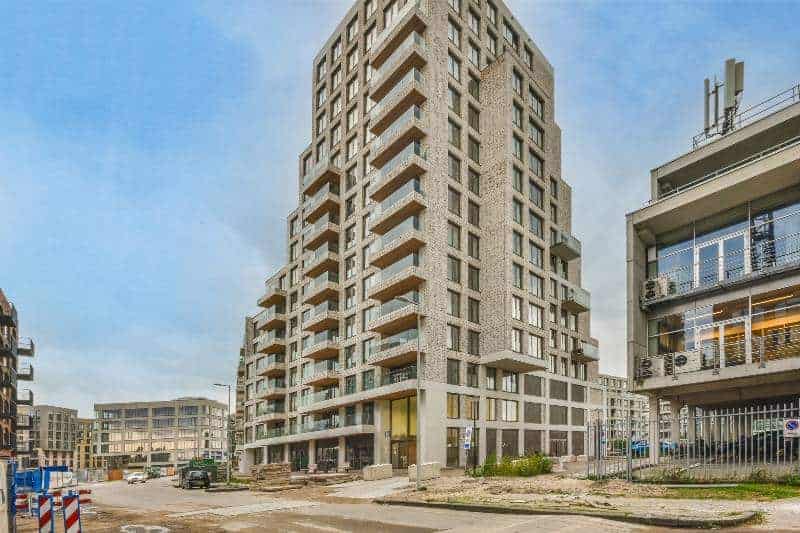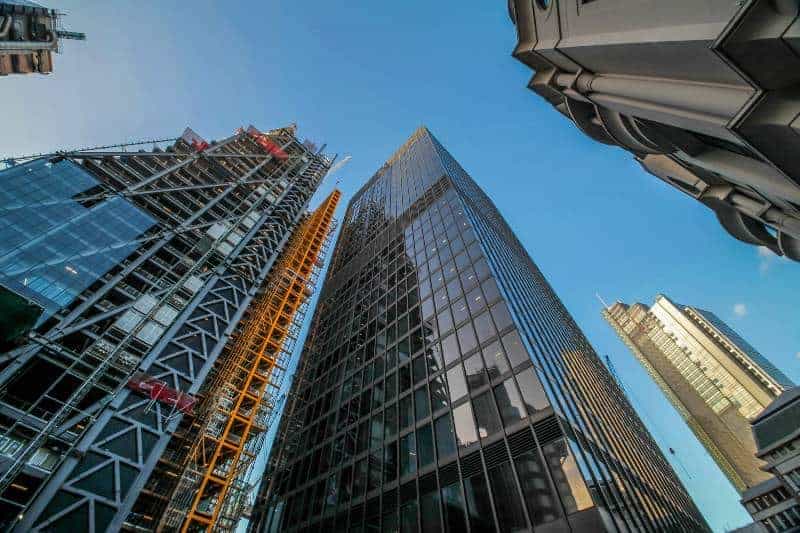Are you looking to rezone commercial property in 2026? If so, you have come to the right place! With median rents declining for 15 consecutive months and significant new construction in the pipeline, many property owners are considering rezoning to adapt to changing market demands. In this blog post, we will provide a comprehensive guide to the property rezoning process.
The Rezoning Commercial Property is a process that allows the owner of a commercial building to obtain permission from the local government for changes to the property. The process will vary depending on the type of property you own and your local government.
Key Takeaways
- The process of altering the terms of property used for a certain plot of land is known as rezoning.
- Laws vary by state, but they generally have the same goal: to manage growth and development in a way that prevents certain types of development from taking place
- The process may take several months, so it is crucial to start early and remember to ask an experienced professional who can help make the process smoother.
Understanding Zoning and Rezoning
If you want to change the “zone” or “use designation” of your property, you need to rezone it. Those who own homes in residentially zoned areas, for instance, are prohibited from using their property for commercial reasons.
This makes it highly unlikely that you will be allowed to start a commercial egg processing facility in your backyard. Even if you have more land than you know what to do with and more eggs than you can count, commercial or agricultural activity, especially farming, is typically prohibited in residentially zoned regions.
If you had the opportunity to own a secluded four-acre wooded oasis in an outer suburb of your city, wouldn’t that be incredible? With no one around to disturb or hear them honking away, imagine having some feathered friends living on this land – chickens!
Make it even more amazing by considering rezoning it for multiple purposes; commercial/industrial applications as well as agricultural and residential plots.
What is rezoning?
Zoning is a crucial step in developing a city. The best-planned cities and towns depend on precise information about how different types of property are used in different areas. Commercial, industrial, and residential zoning all exist in the same area.
Mixed-use properties, or “live/work” places, may feature both residential and commercial sections. The process of rezoning real estate, which may be simple or difficult depending on the needs and requirements of the city, may be necessary when the government or the owner of the property wishes to alter the terms of the property’s use.
If you’re interested in rezoning into mixed-use, read about its Pros and Cons.
You may, for instance, be the sole owner of a vast plot of land that is restricted to the construction of a single dwelling. Potentially increasing your earnings by dividing the land and constructing a second home on it.
This cannot be done legally without first submitting rezoning paperwork to the local authority. In most cases, this is the only thing that is needed for huge properties.
In 2025’s evolving real estate landscape, rezoning has become particularly relevant for commercial property owners. With current mortgage rates at 6.91% and significant changes in how spaces are being used post-pandemic, many owners are exploring rezoning options to maximize property value and adapt to market needs.
Benefits of rezoning commercial property
Here are just some of the benefits of rezoning a commercial property:
| Benefit | Description |
|---|---|
| Increased property value | – Property value may increase significantly when rezoning is proposed for a neighborhood – Subdividing and developing commercial, industrial, or residential properties can lead to higher profits |
| Improved business opportunities | – Rezoning can encourage economic development, especially in dense urban areas – Comprehensive rezoning projects can offer incentives for job creation and increased tax revenue – Rezoning can lead to improvements in transportation infrastructure and public spaces |
| Ability to make changes to the property | – Rezoning allows for changes in the use of existing buildings (e.g., from residential to commercial) – Property owners can make interior improvements to accommodate new uses – Rezoning provides flexibility to adapt to current market trends and technological advances |

Increased property value
There are two key factors that make rezoning land a potentially successful investment: When rezoning is proposed for a neighborhood, the value of a property might skyrocket. Either you or a developer can profit from subdividing and developing commercial and industrial properties or residential unit blocks on your land.
Improved business opportunities
Many property owners are finding value in rezoning for mixed-use developments in 2026, as these projects offer diversified income streams that help hedge against market fluctuations. With commercial rents trending downward and 920,000 multifamily units under construction nationwide, strategic rezoning can help property owners capitalize on shifting market demands.
Ability to make changes to the property
Rezoning commercial property allows you to change the use of an existing building from a single-family residence into an office space or retail store, for example. Additionally, rezoning Commercial property allows you to improve the building’s interior. You can make improvements in many ways with this type of rezoning because there are so many options available when looking at designs and options within the interior of a building.
You can add new features such as modern furniture or equipment that would be more compatible with current market trends and technological advances. You can also improve security features by installing bulletproof glass windows or installing motion sensors throughout the facility so that intruders won’t get too close before they’re detected.

The rezoning process
These are general steps to get your property rezoned:
Step 1: Research the local zoning laws and regulations
When you’re thinking about rezoning your property, you’ll need to research the local zoning laws and regulations. Laws vary by state, but they generally have the same goal: to manage growth and development in a way that prevents certain types of development from taking place. The zoning laws are meant to ensure that neighborhoods remain stable, rather than becoming overly dense or congested.
The process of researching your zoning laws may sound intimidating, but it’s really just a matter of knowing where to look for information.
Start by finding out what type of property you own — if it’s a single-family home or an apartment building, for example — and how much you’d be able to build on it under current zoning rules.
Then, find out who regulates land use in your area. In many states and cities, this is done by elected officials or appointed boards who oversee zoning decisions. More importantly, you need to know what kind of changes you can make and which ones are prohibited by law.
Step 2: Submitting a rezoning application
Submitting a rezoning application is one of the rezoning processes because it allows your local planning department to review proposals in detail. The purpose of submitting a rezoning application is to get an idea of whether or not a certain area should be rezoned and if so, what should be changed.
Step 3: Presenting the case for rezoning to the local government
In presenting the case for rezoning to the local government, first, your proposal must be presented to the appropriate body with enough information so that it can be evaluated properly. This means providing a lot of information about your proposal and why you are proposing it. It also means giving them enough time to consider it and make a decision.
Second, when you present your case to the local government, you must make sure they know exactly what you want them to do. You may need to explain how your proposal will benefit their community or how it will change things for residents of that area. You may even need to show them some other plans that have been proposed for similar areas in their city or county.
Third, once your case has been presented and approved by the appropriate body within your jurisdiction, you will need to submit a formal application for rezoning with all required documentation and fees paid in full before any work can begin on your project.
It is essential to differentiate between a rezoning and a development application.
They do not refer to the same thing at all.
You are not allowed to begin the process of applying for a development permit until you have resolved the zoning issue. If you get a head start on it, you’re going to find that it’s not accepted.
The most important thing is that you be able to present a compelling case for the rezoning. To accomplish this, you will need to have a crystal clear vision as well as plenty of data to back you up.
Step 4: Awaiting a decision on the rezoning application
The rezoning process is a long, complicated one. It is not just a matter of applying for a permit and getting the approval. The city has to make sure that the proposed rezoning will not cause any problems with property rights, traffic, noise, etc. If your application is approved, then you’ll have to negotiate with other parties about how land use should change. However, if there are any problems, the city will not approve the rezoning application.
Los Angeles’ New Zoning Code
Here’s the 2025 Update: Following the 2023 approval of the Downtown Community Plan and New Zoning Code, Los Angeles has begun implementing its modernized zoning approach across various neighborhoods. This new system is particularly relevant as the city adapts to changing market demands, including the shift toward mixed-use developments and flexible spaces.
What’s the Big Idea?
LA’s City Planning team set out to create a zoning system that’s both modern and efficient. The goal? A code that’s easier to use and actually responds to what neighborhoods need. It’s not just about saying “no” to incompatible uses anymore – this new approach looks at how buildings are designed and what they’re used for.
The New Zoning Structure: Breaking It Down
The proposed system has five key parts, or “districts”:
- Form Districts: Think of these as the “how big can it be?” rules.
- Frontage Districts: This is all about curb appeal – how buildings look from the street.
- Development Standards Districts: The nitty-gritty of design – parking, signs, that sort of thing.
- Use Districts: What can you actually do in a building? This covers everything from homes to businesses.
- Density Districts: For residential areas, this sets the number of housing units allowed.
Plus, there are Plan Overlays for when you need that extra layer of specialized rules.
Where Are We Now?
- May 2023: The City Council gave the thumbs up to the Downtown Community Plan and the New Zoning Code.
- Next up: The City Attorney is giving everything a final once-over to make sure it all checks out legally.
- After that, it’s back to the City Council to make it official.
What’s Next?
As LA updates its 35 Community Plans, they’ll be using this new zoning approach to tailor rules for each neighborhood. It’s all about making sure the zoning fits the community’s needs and goals.
Why This Matters
This overhaul shows how cities can adapt to changing urban needs. By focusing on both form and function, LA’s new code aims to create more livable, vibrant neighborhoods while cutting through some of the red tape.
For anyone involved in property development or city planning, keeping an eye on LA’s approach could offer valuable insights into the future of urban zoning.
To learn more about Los Angeles’ new zoning code, visit the official City Planning website.
Challenges of Rezoning Commercial Property
Here are some of the challenges concerning rezoning a commercial property:
The cost of the rezoning process
When considering the cost to rezone a property from commercial to residential in 2026, fees typically start at $24,000 for the application alone, and can increase significantly based on property size and location. Given current market conditions, with commercial rents declining for 15 straight months, many owners find this investment worthwhile for long-term property value.
The process can be complicated, expensive, and time-consuming, especially when it comes to commercial properties.
Opposition from the community or local government
In some cases, the local government or local planning commission body may be opposed to rezoning a commercial property to accommodate a new use that they do not want. This might be because they do not want more commercial traffic in their community, or because they think that the development will have an adverse effect on the environment or on traffic flows in the area.
If you are considering rezoning your commercial property, you should always make sure that you have considered all of the issues and risks before proceeding with the project. For example, if there is any risk associated with noise or pollution from the proposed development, then you should try to work out a solution with your neighbors before proceeding further.
In 2025, with major shifts toward mixed-use developments, local governments are often more receptive to rezoning requests that align with urban development trends. For example, projects converting underutilized commercial spaces into mixed residential and retail developments typically face less opposition, as they address both housing needs and maintain commercial vitality.
The time it can take to complete the rezoning process
The rezoning process can be incredibly tedious and time-consuming. There are many factors to consider, including the distance between the property and the proposed zoning area, whether it’s residential or commercial, and how much traffic an applicant can expect to generate.
The time it takes to complete the rezoning process is a major concern for many property owners. As a matter of fact, it takes approximately four (4) months or more.
In addition to the challenges mentioned above, rezoning efforts can also face resistance due to concerns about the social and economic impacts of changing land use patterns. A recent study conducted in the Greater Los Angeles region highlights the stark disparities that can arise from restrictive single-family zoning practices.
A recent study has shed light on the shocking disparities in land use and zoning across the Greater Los Angeles region. The findings, released by a team of researchers, reveal that a staggering 40.67% of the total land in the area is exclusively reserved for single-family housing. In stark contrast, a mere 11.8% is allocated for denser, multi-family developments.
The study, which analyzed data from 191 cities spanning six counties, including Imperial, Los Angeles, Orange, Riverside, San Bernardino, and Ventura, uncovered a troubling trend. As the proportion of single-family-only zoning increased in a neighborhood, so did the population of white and Asian residents. Conversely, the Latino population saw a significant decrease in these areas. The region’s Black residents also dwindled as the percentage of single-family-only zoned areas grew.
These findings echo a previous study conducted by the same research team in the San Francisco Bay Area. That investigation revealed that an astonishing 85% of residential land was exclusively zoned for single-family housing, with more restrictive zoning correlated with whiter and wealthier communities.
Stephen Menendian, the study’s co-author and assistant director of OBI, pulled no punches in his assessment of the situation. “This study is damning evidence that low-density zoning in the Los Angeles region powerfully excludes people on the basis of race and class,” he declared. “And, as we can see from the longitudinal data, is the principal mechanism for hoarding resources in ways that shape life outcomes.”
The researchers also discovered striking disparities in home prices, with median values in neighborhoods that are at least 90% single-family-only zoned ($811,492) more than double those in areas with less than 10% single-family-only zoning ($405,875). Educational outcomes, such as math proficiency, high school graduation rates, and college degrees, were also found to be better in more exclusionary communities. Even environmental health conditions, like air quality and lead exposure, were superior in these areas.
Perhaps most alarming is the clear correlation between a child’s neighborhood zoning and their future earning potential. Children born into families with incomes at the 75th percentile who grew up in communities with nearly 100% single-family zoning ended up making over $10,000 more per year as adults compared to those from families at the same income level but living in communities with 25% or less single-family zoning.
To help you better grasp the significant findings of this study, I’ve created a table that summarizes the key data points across various aspects of community life. Take a moment to review the information below, as it provides valuable insights into the far-reaching impacts of restrictive zoning practices.
| Aspect | Key Findings |
|---|---|
| Land Use Distribution | – 40.67% of total land exclusively reserved for single-family housing – 11.8% of total land available for denser, multi-family developments |
| Demographic Trends | – Increased proportion of single-family-only zoning correlates with: – Higher white and Asian populations – Lower Latino population – Declining Black population |
| Home Prices | – Median home value in 90%+ single-family-only zoned neighborhoods: $811,492 – Median home value in <10% single-family-only zoned neighborhoods: $405,875 |
| Educational Outcomes | – Better outcomes in more exclusionary communities: – Math proficiency – High school graduation rates – College degrees |
| Environmental Health | – Superior conditions in more exclusionary communities: – Air quality – Lead exposure |
| Future Earning Potential | – Children from 75th percentile income families: – Nearly 100% single-family zoning: $10,000+ more per year as adults – 25% or less single-family zoning: Lower adult earnings |
Environmental Impact of Rezoning
When it comes to rezoning commercial property, it’s essential to consider the potential environmental impact. After all, the choices we make today can have far-reaching consequences for our local ecosystems, green spaces, and overall sustainability.
On the bright side, rezoning can open up exciting opportunities to embrace eco-friendly development practices. Imagine transforming an old industrial site into a vibrant mixed-use community, complete with energy-efficient buildings, rooftop gardens, and solar panels. By making smart, sustainable choices during the rezoning process, we can create developments that not only benefit the economy but also help reduce our carbon footprint and contribute to a greener future.
But let’s not sugarcoat it – rezoning can also have some serious downsides if we’re not careful.
When we increase the density or intensity of land use, it can put a lot of pressure on our local infrastructure. More people means more strain on our water and sewer systems, and more traffic means more air pollution. And if we’re not mindful, rezoning can sometimes lead to the destruction of precious green spaces, like parks or natural habitats that are home to diverse plant and animal species.
So, what can we do to minimize the negative environmental impacts of rezoning? First and foremost, it’s crucial for property owners and developers to play by the rules. That means following all the relevant environmental regulations at the local, state, and federal levels. It might involve conducting thorough environmental impact assessments, securing the necessary permits, and adopting sustainable development practices that have been proven to work.
Speaking of sustainable practices, there are plenty of ways to make rezoning more environmentally friendly. For starters, we can prioritize the preservation and enhancement of green spaces within the development. Whether it’s incorporating parks, gardens, or natural landscaping, these green oases can help maintain biodiversity and provide a much-needed respite from the urban jungle.
We can also embrace green building features and sustainable design principles. Think energy-efficient systems, water-saving measures, and the use of eco-friendly materials. By making these choices during the rezoning and development process, we can create buildings that are not only beautiful and functional but also kind to the planet.
Another way to reduce the environmental impact of rezoning is to encourage alternative modes of transportation. Instead of relying solely on cars, we can design communities that make it easy and enjoyable to walk, bike, or take public transit. By reducing our dependence on fossil fuels, we can help combat air pollution and create healthier, more vibrant neighborhoods.
Collaboration is key. Property owners and developers should actively seek out partnerships with local environmental organizations and community groups. By working together, we can identify potential environmental concerns early on and develop strategies to address them head-on. This kind of proactive, collaborative approach can go a long way in ensuring that rezoning projects are not only successful but also sustainable.

Rezoning for a Changing World: Adapting Commercial Properties for 2026 and Beyond
The real estate landscape is in constant flux, and 2026 is no exception. With shifting demographics, evolving work patterns, and a growing focus on sustainability, commercial property owners are increasingly turning to rezoning as a tool to adapt and thrive. Let’s explore some of the key trends driving rezoning decisions in 2026 and how these changes are shaping the future of our cities.
Rezoning for Sustainability: Meeting 2026 Environmental Goals
Environmental concerns are top of mind for many communities in 2026, and rezoning is playing a crucial role in promoting sustainable development. Cities and developers are recognizing the need to reduce carbon footprints, conserve resources, and create healthier built environments.
Rezoning can facilitate this shift by:
- Encouraging Green Building Practices: Many municipalities are now incorporating green building standards into their zoning codes, incentivizing developers to adopt sustainable building practices. For instance, some cities offer density bonuses or expedited permitting for projects that achieve LEED certification or meet other green building criteria. This trend is particularly strong in California, where the state’s Green Building Standards Code (CALGreen) sets mandatory requirements for energy efficiency, water conservation, and indoor air quality.
- Promoting Renewable Energy Integration: Rezoning can also pave the way for the integration of renewable energy sources into commercial properties. For example, zoning ordinances can be amended to allow for the installation of solar panels on rooftops or the construction of wind turbines on site. In some cases, rezoning may even be necessary to facilitate the development of community solar projects or microgrids.
- Facilitating Sustainable Transportation: Rezoning can also support sustainable transportation options by encouraging the development of walkable, bikeable communities with access to public transit. This can be achieved through zoning changes that promote mixed-use development, reduce parking requirements, and prioritize pedestrian and bicycle infrastructure.
Case Study: The Brewery Blocks, Portland, Oregon
A prime example of sustainable rezoning is the Brewery Blocks development in Portland, Oregon. This former industrial area was rezoned for mixed-use development, incorporating a variety of sustainable features, including green roofs, rainwater harvesting systems, and a district energy system that utilizes renewable energy sources.
The Brewery Blocks has become a model for sustainable urban redevelopment, demonstrating how rezoning can be used to create vibrant, environmentally responsible communities.
The Rise of Mixed-Use Developments in 2026: Rezoning for the Future
Mixed-use developments, which combine residential, commercial, and sometimes even industrial uses within a single project, are becoming increasingly popular in 2026. This trend is driven by a number of factors, including:
- Changing Demographics: As the Millennial and Gen Z generations enter their prime working and home-buying years, they are showing a strong preference for walkable, urban environments with easy access to amenities and services. Mixed-use developments cater to this desire by providing a “live-work-play” lifestyle.
- Evolving Work Patterns: The rise of remote work and the gig economy has created a demand for flexible, adaptable spaces that can accommodate a variety of work styles. Mixed-use developments often incorporate co-working spaces, shared offices, and other flexible work environments.
- Increased Resilience: Mixed-use developments can be more resilient to economic downturns than single-use projects. If one sector (e.g., retail) struggles, the other components (e.g., residential) can help to stabilize the development.
Case Study: The Wharf, Washington, D.C.
The Wharf, a massive mixed-use development on the Southwest Waterfront in Washington, D.C., exemplifies the transformative power of rezoning. This formerly underutilized industrial area was rezoned to allow for a vibrant mix of residential, retail, office, and entertainment spaces. The Wharf has revitalized the waterfront, creating a new destination for residents and visitors alike.
Rezoning and the Evolving Retail Landscape: Adapting to 2026 Consumer Trends
The retail landscape is undergoing a dramatic transformation in 2026, driven by the growth of e-commerce and changing consumer preferences.8 Rezoning can help commercial properties adapt to these trends by:
- Allowing for Experiential Retail: As online shopping continues to grow, brick-and-mortar retailers are increasingly focusing on creating unique, experiential shopping environments that cannot be replicated online. Rezoning can allow for the creation of spaces that incorporate entertainment, dining, and other attractions alongside traditional retail offerings.
- Facilitating Omnichannel Retail: Rezoning can also support the growth of omnichannel retail, which integrates online and offline shopping experiences. For example, zoning changes can allow for the creation of dedicated pick-up and delivery zones for online orders, or the conversion of underutilized retail space into micro-fulfillment centers.
- Adapting to Changing Retail Formats: The rise of pop-up shops, mobile retail, and other innovative retail formats requires flexibility in zoning regulations. Cities are increasingly adopting zoning codes that allow for temporary uses and flexible space configurations to accommodate these evolving trends.
Case Study: Santana Row, San Jose, California
Santana Row, a mixed-use development in San Jose, California, demonstrates how rezoning can support a thriving retail environment.9 This project combines upscale retail, dining, entertainment, and residential uses in a pedestrian-friendly setting. Santana Row has become a popular destination for shoppers and diners, demonstrating the appeal of experiential retail in the 21st century.
Rezoning for Remote Work and Flexible Spaces: 2026 and Beyond
The COVID-19 pandemic accelerated the shift towards remote work, and this trend is expected to continue in 2026 and beyond.10 Rezoning can play a key role in facilitating the creation of flexible workspaces that cater to the needs of remote workers and businesses.
- Allowing for Co-working Spaces and Shared Offices: Many cities are now updating their zoning codes to specifically allow for co-working spaces and shared offices, recognizing the growing demand for these types of flexible work environments. This can involve creating new zoning classifications or amending existing ones to accommodate these uses.
- Promoting Adaptive Reuse of Existing Buildings: Rezoning can also facilitate the adaptive reuse of existing buildings for flexible workspaces. For example, a vacant office building could be rezoned and renovated to create a co-working space or a business incubator.
- Supporting Home-Based Businesses: As more people work from home, some cities are exploring zoning changes that make it easier to operate home-based businesses. This can involve relaxing restrictions on home occupations or providing incentives for the creation of home offices.
Case Study: WeWork, Global
WeWork, a global provider of flexible workspaces, has been a driving force behind the demand for co-working spaces and shared offices.11 The company’s rapid expansion has been facilitated by rezoning efforts in many cities, which have allowed WeWork to establish locations in a variety of neighborhoods and building types.
Looking Ahead:
Rezoning is a powerful tool that can be used to shape the future of our cities. By embracing sustainable development, promoting mixed-use projects, adapting to the evolving retail landscape, and facilitating flexible workspaces, communities can create vibrant, resilient, and inclusive environments that meet the needs of the 21st century.
As we move forward, it will be crucial for property owners, developers, and policymakers to work together to ensure that rezoning is used in a way that benefits both the economy and the environment.
Rezoning Commercial Property FAQs
Can I Rezone Commercial Property to Residential?
Is there a chance that my rezoning request will be approved?
You need to make sure that you’re in the right place before you start the process as there are different types of rezoning available in different areas.
Is it necessary to seek help when rezoning my property?
How much does it cost to rezone from residential to commercial?
The process involves letting the public know about the proposed change and holding meetings where people can share their thoughts.
The city will also look at how the change might affect the environment. Rezoning a property can be pretty pricey, often costing $24,000 or more just for the application. It can also take a long time – usually nine months or longer to get everything done.
Can you build residential on commercial property in California?
Conclusion
Rezoning your commercial property can have many potential benefits that make the process worthwhile. However, it’s important to carefully consider all the implications before making a decision.
The best way to ensure you’re making the right choice for your property is to consult with a professional who can advise you on the best course of action.
If you’re interested in learning more about rezoning and how it could impact your property, I offer consultations. Schedule a call today with me and I will be happy to talk with you about your options.




